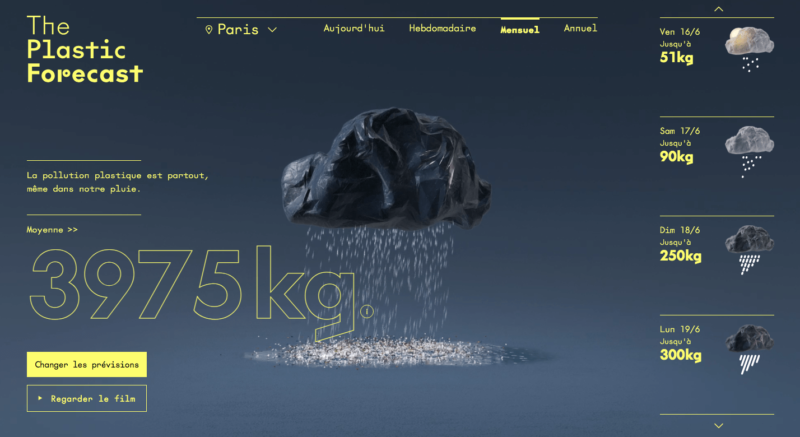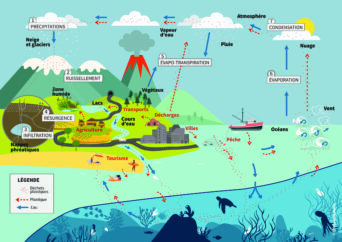Come rain or come… plastic microparticles!
Plastic pollution
Science
14 June 2023
A brand-new type of weather report was inaugurated in Paris on May 25: a plastic pollution forecast. A clever initiative by the Australian Minderoo Foundation to warn of the omnipresence of plastic particles in our environment.

FROM THE HUFFINGTON POST
“The Plastic Forecast” is an experimental weather forecast aimed at estimating the pollution produced by plastic microparticles at a given location. It was inaugurated in Paris on May 25, 2023, just as the French capital was preparing to host the 2nd round of negotiations for a future treaty on plastic pollution.
According to Minderoo, the Australian foundation behind the project, a heavy, persistent drizzle of billions of microplastic particles regularly falls around the world.
Taking Paris as an example (other cities are soon to be added to the simulation tool), the Plastic Forecast indicated that 40 and 48 kilograms of pieces of plastic were expected to fall on the capital during the week of the conference alone. Relatively little “precipitation”, and for good reason: not a drop of rain was expected.
While plastic particles in the atmosphere constantly accumulate on the ground, as Plastic Forecast points out, nearly 10 times as many can fall when it rains.
The release of Plastic Forecast was accompanied by an extensive awareness-raising campaign – posters in the metro, on bus shelters and on digital billboards throughout the negotiations.
Plastic Weather” bulletins, imitating those of Météo France, can be consulted on the Plasticforecast.com website.
"Unsuspected" damage to health
“Plastic particles break down in the environment and this toxic cocktail ends up in our bodies, where it causes unsuspected damage to our health,” says Marcus Gover, head of plastics research at the Australian Minderoo Foundation.
Concern over the impact of plastics on the environment and health has grown in recent years, with a crescendo of research documenting their ubiquity. In nature, multicolored microplastics – smaller, by definition, than five millimeters in diameter – have been found in the ice near the North Pole and in the entrails of fish swimming in the deepest recesses of the ocean.
In humans, microscopic pieces have been detected in blood, breast milk and placenta.
Getting out from under the "ostrich policy
Animal tests have linked chemicals in microplastics to increased risks of cancer, reproductive problems and DNA mutations. But data on human health is still lacking.
“The plastics in the body that should worry us most are probably those between 10 nanometers and one micrometer,” pediatrician Christos Symeonides, a researcher at the Minderoo Foundation, tells AFP. ”These are the ones most likely to cross our biological membranes and penetrate tissues, including the blood-brain barrier“, the barrier between blood and the nervous system, he adds. ”When it comes to the health risks of microplastics, we’ve only just begun to get our heads out of the sand,” he says.
Plastic Forecast’s predictions, however, only concern much larger particles, mainly synthetic fibers of at least 50 microns. By comparison, a human hair measures around 80 microns (or 80,000 nanometers). ”It is therefore likely that the amount of plastic actually accumulated is far greater than the Plastic Forecast predictions,” warns the weather forecast on its website.
Steadily increasing production
The method developed by the Minderoo Foundation doesn’t actually measure plastic floating in the atmosphere in real time. It extrapolates research carried out in Paris since 2015, which collected samples at several locations throughout the year and sorted them in the laboratory.
Led by French scientists, this pioneering work revealed that most of the plastic particles falling on the 2,500 square kilometers of the Paris urban unit were nylon and polyester, probably from clothing. And some were tire residues, scattered particularly when braking.
➡️ To find out more about the aerosolization of plastic pollution, we recommend this article.
